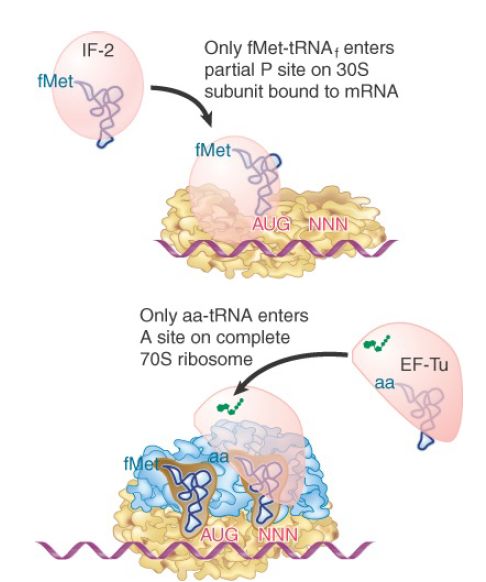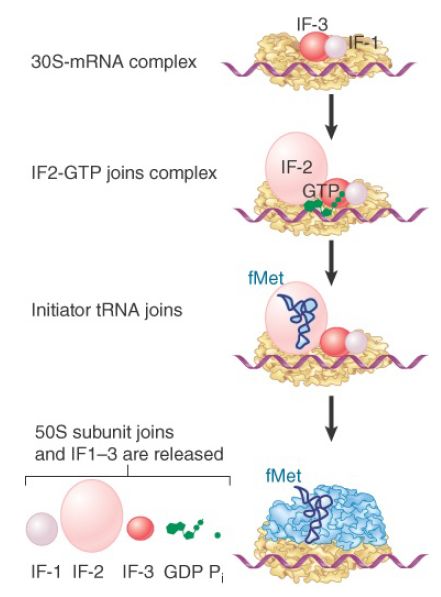


 النبات
النبات
 الحيوان
الحيوان
 الأحياء المجهرية
الأحياء المجهرية
 علم الأمراض
علم الأمراض
 التقانة الإحيائية
التقانة الإحيائية
 التقنية الحيوية المكروبية
التقنية الحيوية المكروبية
 التقنية الحياتية النانوية
التقنية الحياتية النانوية
 علم الأجنة
علم الأجنة
 الأحياء الجزيئي
الأحياء الجزيئي
 علم وظائف الأعضاء
علم وظائف الأعضاء
 الغدد
الغدد
 المضادات الحيوية
المضادات الحيوية|
Read More
Date: 21-5-2021
Date: 8-12-2015
Date: 28-10-2020
|
Use of fMet-tRNAf Is Controlled by IF-2 and the Ribosome
KEY CONCEPT
- IF-2 binds the initiator fMet-tRNAf and allows it to enter the partial P site on the 30S subunit.
In bacterial translation, the meaning of the AUG and GUG codons depends on their context. When the AUG codon is used for initiation, a formyl-methionine begins the polypeptide; when it is used within the coding region, methionine is added to the polypeptide. The meaning of the GUG codon is even more dependent on its location. When present as the first codon, formylmethionine is added, but when present within a gene it is bound by Val-tRNA, one of the regular members of the tRNA set, to provide valine as specified by the genetic code.
How is the context of AUG and GUG codons interpreted? Figure 1 illustrates the decisive role of the ribosome when acting in conjunction with accessory factors.

FIGURE 1. Only fMet-tRNAf can be used for initiation by 30S subunits; other aminoacyl-tRNAs (aa-tRNAs) must be used for elongation by 70S ribosomes.
In an initiation complex, the small subunit alone is bound to mRNA. The initiation codon lies within the part of the P site carried by the small subunit. The only aminoacyl-tRNA that can become part of the initiation complex is the initiator, which has the unique property of being able to enter directly into the partial P site to bind to its complementary codon.
When the large subunit joins the complex, the partial tRNA-binding sites are converted into the intact P and A sites. The initiator fMettRNAf occupies the P site, and the A site is available for entry of the aminoacyl-tRNA complementary to the second codon of the mRNA. The first peptide bond forms between the initiator and the next aminoacyl-tRNA.
Initiation occurs when an AUG (or GUG) codon lies within a ribosome-binding site because only the initiator tRNA can enter the partial P site formed when the 30S subunit binds de novo to the mRNA. During elongation only the regular aminoacyl-tRNAs can enter the complete A site.
Accessory factors are critical for the binding of aminoacyl-tRNAs. All aminoacyl-tRNAs associate with the ribosome by binding to an accessory factor. The factor used in initiation is IF-2 . The accessory factor used at elongation, EF-Tu, is discussed in the section later in this chapter titled Elongation Factor Tu Loads Aminoacyl-tRNA into the A Site.
The initiation factor IF-2 places the initiator tRNA into the P site. By forming a complex specifically with fMet-tRNAf , IF-2 ensures that only the initiator tRNA, and none of the regular aminoacyl-tRNAs, participates in the initiation reaction. Conversely, EF-Tu, which places aminoacyl-tRNAs in the A site, cannot bind fMet-tRNAf , which is therefore excluded from use during elongation.
The accuracy of initiation is also assisted by IF-3, which stabilizes binding of the initiator tRNA by recognizing correct base pairing with the second and third bases of the AUG initiation codon. Figure 2 details the series of events by which IF-2 places the fMet-tRNA initiator in the P site. IF-2, bound to GTP, associates with the P site of the 30S subunit. At this point, the 30S subunit carries all the initiation factors. fMet-tRNA then binds to the IF-2 on the 30S subunit, and IF-2 transfers the tRNA into the partial P site.

FIGURE 2.IF-2 is needed to bind fMet-tRNAf to the 30S– mRNA complex. After 50S binding, all IFs are released and GTP is cleaved.



|
|
|
|
كيف تعزز نمو الشعر الصحي؟
|
|
|
|
|
|
|
إطلاق ثاني مصنع في أيسلندا لالتقاط ثاني أكسيد الكربون
|
|
|
|
|
|
بعد إكمال طباعة كتاب (قراضة النضير وخلاصة التفسير) .. العتبة العلوية المقدسة توزع نسخاً منه على مكتبات النجف الأشرف
|
|
|
|
على مساحة 42 ألف متر مربع ... أكبر مشروع علمي ثقافي فكري للأطفال تنفذه العتبة العلوية المقدسة
|
|
|
|
لخدمة المتشرفين بأداء المناسك لموسم الحج القادم .. العتبة العلوية المقدسة تنفذ برنامج (الحج الافتراضي)
|
|
|
|
لتطوير قدرات الخدم في العتبة العلوية المقدسة .. إطلاق مجموعة من الدورات و ورش العمل المتنوعة
|